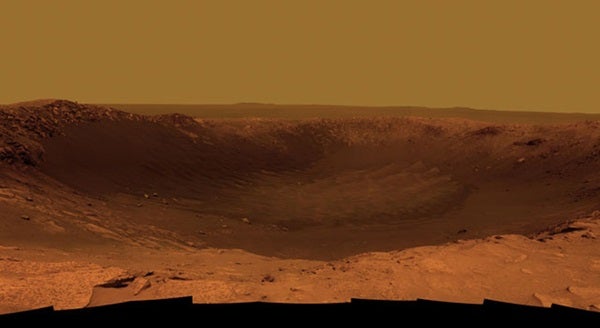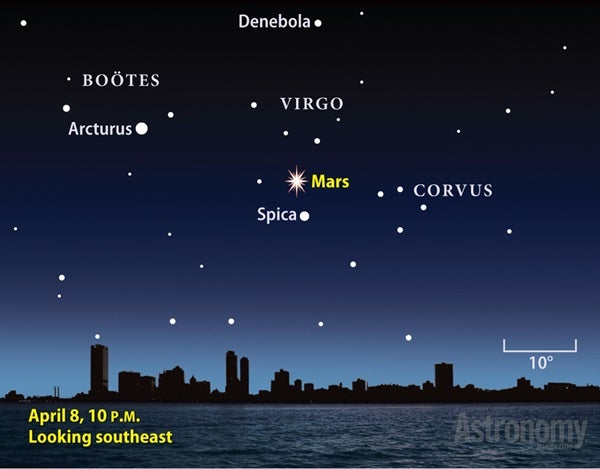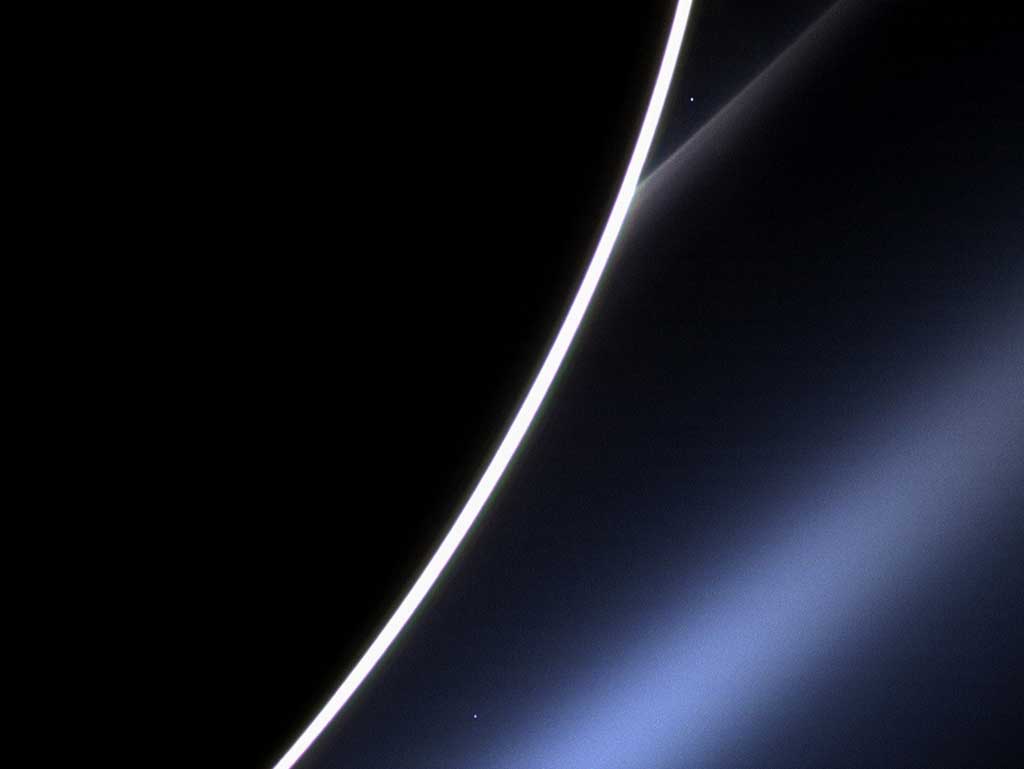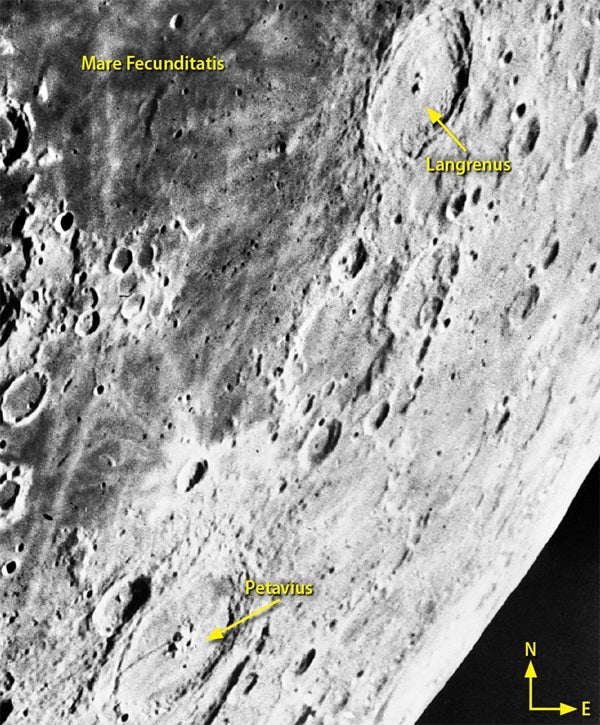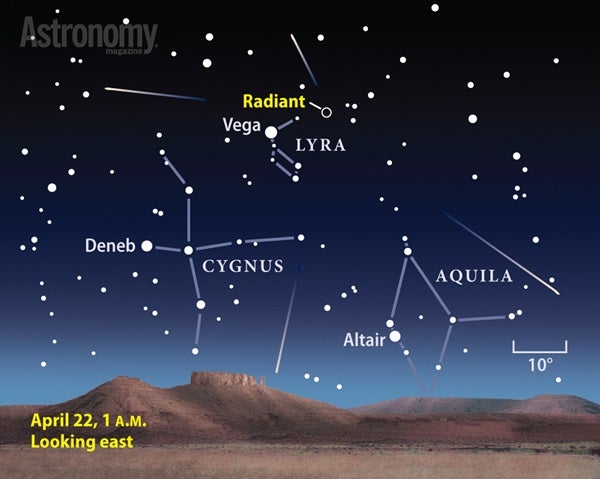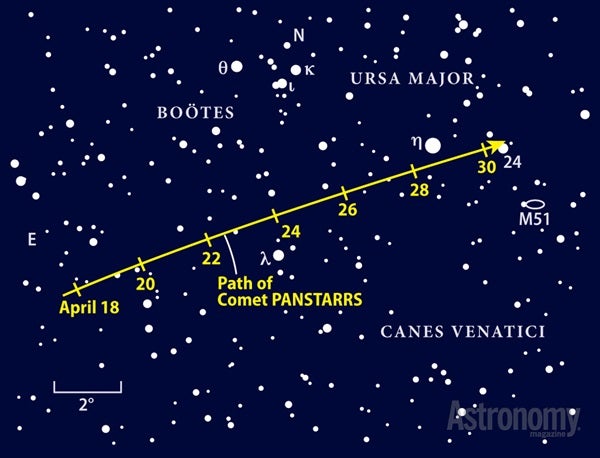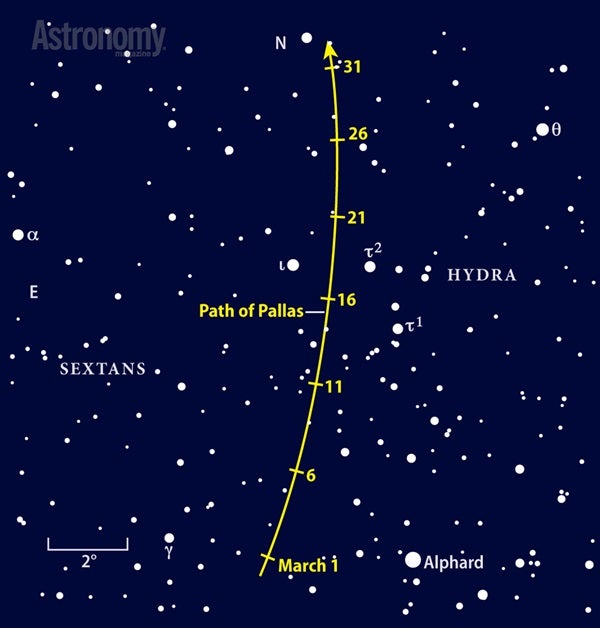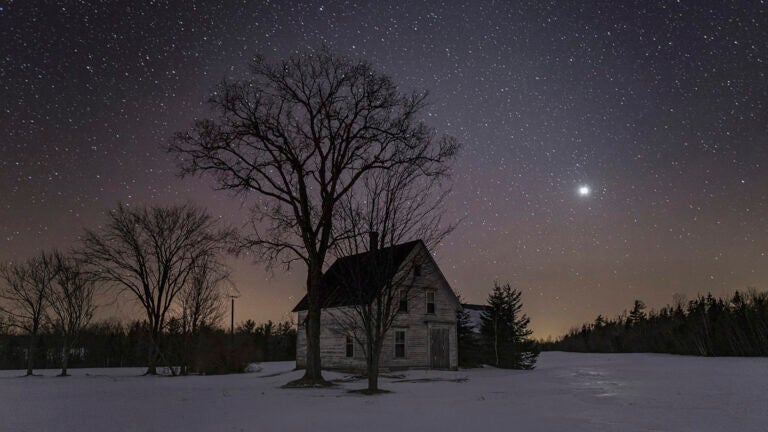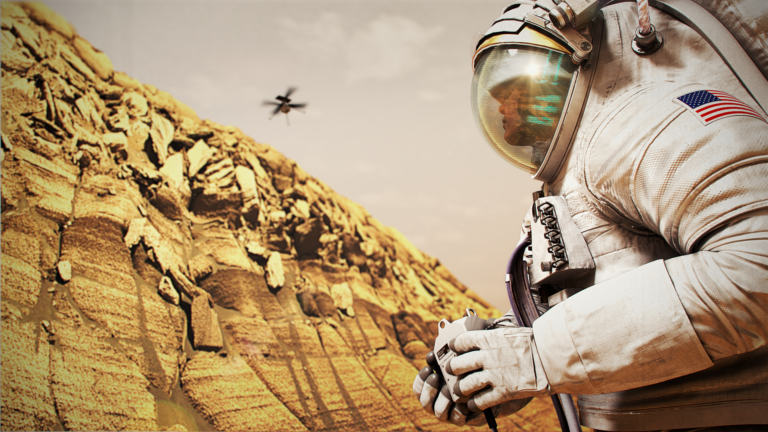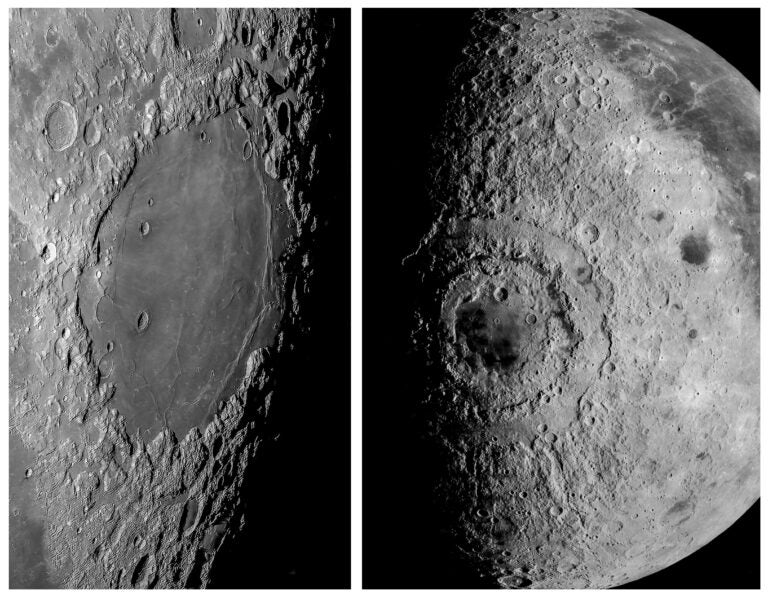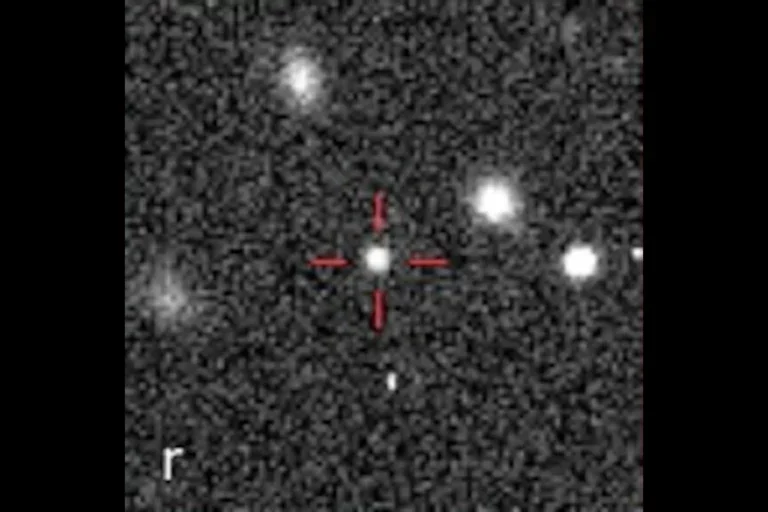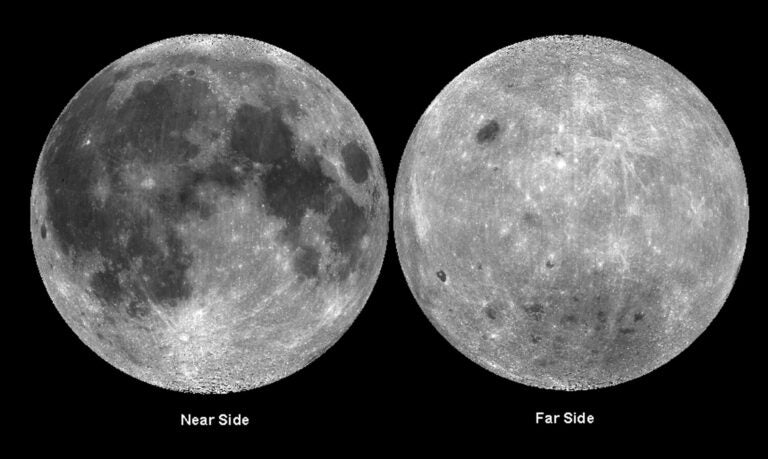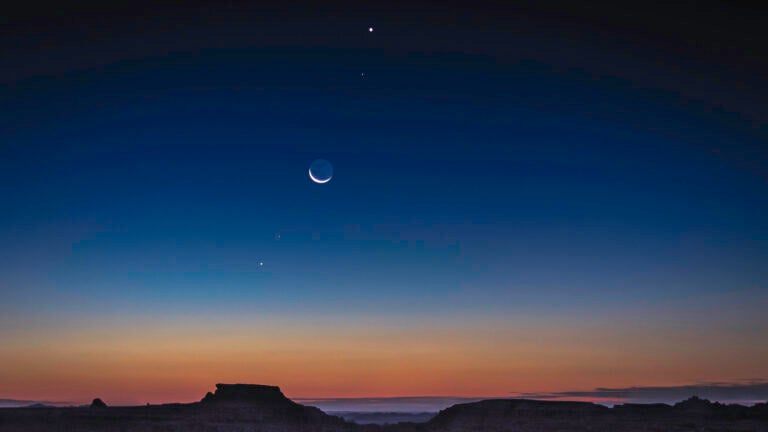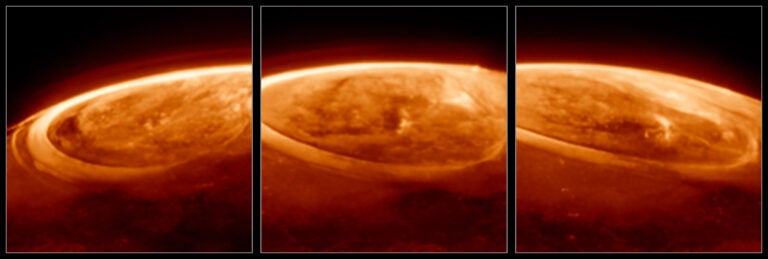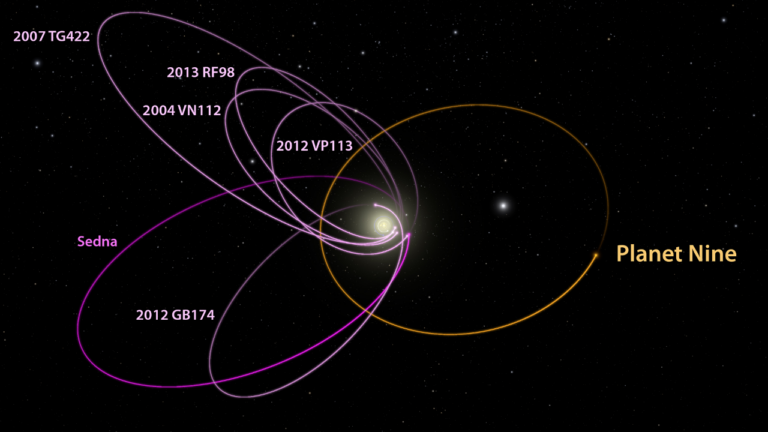The first of 2014’s two total lunar eclipses occurs at the midpoint of this action-packed month. April’s other highlights include Mars reaching opposition and shining brighter than at any time in the past eight years, fine views of Jupiter in the evening and Saturn later at night, and Venus sliding past Neptune shortly before dawn.
As darkness falls April 1, Jupiter rides above the southwestern horizon. It stands more than 60° high from mid-northern latitudes and doesn’t set until after 2 a.m. local daylight time. Even by April’s close, the solar system’s largest planet remains on view past midnight. Jupiter shines at magnitude –2.1 at midmonth and appears brighter thanany other point of light in the evening sky.
The giant planet’s high altitude after sunset provides observers with two to three hours of prime viewing through their telescopes. Although Jupiter’s apparent diameter shrinks from 38″ to 35″ during April, it’s plenty big enough to show exquisite detail. Look for a series of alternating bright zones and darker belts that run parallel to the planet’s equator. The most pronounced atmospheric activity tends to occur near the edges of these belts. The Great Red Spot appeared conspicuous earlier this year and should stand out if it lies on the Earth-facing hemisphere.
Jupiter’s four bright moons put on a dynamic show through any telescope. An especially cool alignment occurs the evening of April 21. Shortly after 11 p.m. EDT, three of the moons — Io, Europa, and Callisto — form a perfectly straight line just west of Jupiter. Although the planet’s moons line up frequently, most times they string out parallel to the jovian equator. On the 21st, the three moons are arrayed nearly perpendicular to the equator.
If you start watching a few minutes before 11 p.m. EDT, you’ll see Io’s eastward motion carry it directly between Europa and Callisto. The precise alignment lasts no more than 15 minutes centered around 11:15 p.m. EDT. (As a bonus, Europa’s shadow falls on the jovian cloud tops throughout this period.)
As Jupiter sinks in the west, Mars rises in the east in the company of Virgo the Maiden. The Red Planet reaches opposition April 8, when it rises near sunset and appears highest in the south around 1 a.m. local daylight time. It then shines at magnitude –1.5, brighter than it has since December 2007 and marginally more brilliant than the sky’s brightest star, Sirius.
The Red Planet comes closest to Earth six days after opposition. It then appears 15.2″ across through a telescope, though its diameter doesn’t drop below 14.6″ all month. The negligible difference means that any telescope with excellent optics should deliver nice views, particularly during moments of good seeing when the air above is steady and the stars don’t seem to twinkle. Because light from Mars passes through less of Earth’s atmosphere when it lies higher in the sky, the best observing should come in the hours around midnight.
What can you see on the martian surface? The one constant will be the north polar cap. This bright white region appears prominent because the planet’s north pole currently tilts about 23° in our direction, and the cap’s carbon-dioxide ice reflects most of the sunlight that hits it. It is now early summer in Mars’ northern hemisphere, so you should be able to see the cap shrink during April.
The rest of the martian disk presents more subtle charms. The surface markings visible depend largely on when you observe. Because Mars rotates once every 24.7 hours, features appear to move backward (from west to east) if you observe at the same time each night. During a full month, the planet’s entire face shows up at one time or another.
Let’s begin at midnight EDT the night of April 1/2. The hemisphere facing Earth consists mostly of bland desert regions with few dark features. The most prominent dark marking is Mare Cimmerium in the south, while the plains of Utopia form a dark band around the north polar region.
At opposition on April 8/9, the martian deserts take center stage. You won’t see many dark features until around April 15, when the midnight hour reveals the dark patches Mare Erythraeum and Aurorae Sinus south of the equator and Acidalia Planitia toward the north polar region. The late evening of April 21 brings Acidalia Planitia near the martian central meridian, the line of longitude that runs from pole to pole and passes through the center of the planet’s disk. That same night, the fine linear dark feature Sinus Sabaeus appears just east of the central meridian.
April’s final week features late-evening views of Mars’ most prominent dark area, Syrtis Major. This wedge-shaped marking appears near the planet’s eastern limb by midnight EDT on April 25/26. It backs up each succeeding night until it lies on the central meridian April 30.
It’s easy to see why Mars grabs most of the attention this month, but another stunning planet gives it a run for its money. Saturn brightens from magnitude 0.3 to 0.1 during April, which makes it approximately 10 times brighter than any of the background stars in the constellation Libra the Balance. The planet rises around 10:30 p.m. local daylight time in early April and two hours earlier (during twilight) by month’s end.
Saturn will reach opposition in May, and its stunning appearance through a telescope during April nearly matches this upcoming peak. For the best views, wait until the planet climbs higher in the sky after midnight. In mid-April, Saturn’s disk measures 18″ across while the rings span 42″ and tilt 22° to our line of sight. This steep angle provides a great vantage point for seeing the rings’ structure.
As you marvel at Saturn’s beauty, take a few minutes to track down the planet’s brighter moons. Titan shines at 8th magnitude and shows up through any scope. You’ll need a 4-inch instrument to spot Tethys, Dione, and Rhea, which all glow at 10th magnitude. Iapetus appears similarly bright when it lies farthest west of the planet (9′ away) in mid-April. This two-faced moon dims as it moves away from greatest western elongation and its dark hemisphere turns more toward Earth.
As Mars and Saturn wheel into the western sky before dawn, Venus rises in the east. The brilliant planet pokes above the horizon about two hours before the Sun in early April and 20 minutes later by month’s end. You won’t have any trouble distinguishing Venus — at magnitude –4.3 in mid-April, it is the brightest point of light in the night sky. A telescope reveals slow changes in the planet’s appearance. On April 1, Venus’ disk spans 22″ and the Sun illuminates just over half of it. By the 30th, it appears 17″ across and two-thirds lit.
You can use the brightest planet as a guide to the dimmest April 12. That morning, Venus passes just 0.7° north of Neptune. Although the two appear along the same line of sight, Neptune lies 37 times farther from Earth and glows dimly at magnitude 7.9. Spying the distant planet through a telescope will be difficult, especially after twilight starts.
The solar system’s other two planets deserve only brief mentions. Mercury lies deep in morning twilight in early April. From mid-northern latitudes on the 1st, it appears just 1° high a half-hour before sunrise. It passes behind the Sun from our perspective on the 25th. Uranus stands on the Sun’s far side the night of April 1/2. Northern Hemisphere observers likely won’t see the 6th-magnitude object even at month’s end, when it rises during twilight.
The year’s first total lunar eclipse occurs the night of April 14/15 for observers in the Americas west to eastern Australia. The Moon first dips into the darkest part of Earth’s shadow at 1:58 a.m. EDT, with totality starting at 3:07 a.m. EDT and lasting 78 minutes. For complete details on viewing this event, see “Observe April’s spectacular lunar eclipse” on p. 52.
Two weeks after the Moon crosses Earth’s shadow, our planet enters the Moon’s shadow. April 29’s annular solar eclipse will leave a ring of sunlight visible around our satellite, but only for the hardiest of souls — you have to be in Antarctica to witness the peak. Residents of Australia can observe a partial eclipse. People along the country’s southern coast will see the Moon block about 60 percent of the Sun in late afternoon while those in Tasmania will enjoy 70 percent coverage.
TWO LARGE CRATERS DOT THE LUNAR CRESCENT
Moon observers love spring. Northern Hemisphere skywatchers have unparalleled views of the thin lunar crescent resplendent with earthshine perched in an indigo sky above a horizon of fiery orange. Through a telescope, the large crater walls and peaks that lie near the limb cast long shadows, delighting both novices and selenophiles (or lunatics, as friends call them). The enjoyment lasts awhile, too, because the steep angle of the ecliptic to the western horizon places the Moon high in the twilight sky.
Expect great views the evening of April 2, when the Sun’s rays just catch the central peaks and western walls of the large craters Langrenus and Petavius. Langrenus, which spans 82 miles, is not as young as the better-known craters Copernicus and Tycho, but its features appear relatively sharp. Look for a couple of central mountain peaks and their slumped walls.
Petavius lies to Langrenus’ south and is a bit bigger (110 miles across), a bit older, and sports extra features. Its rim appears softer, a telltale sign that it has spent more time under bombardment from solar system rubble. Its most intriguing feature is a large radial fracture that runs southwest from a complex cluster of central peaks. Look closely, and you also should be able to pick up a curved crack closer to the rim. Both of these fractures formed when lava from below heaved up the floor and later subsided. Junior bakers see these effects in their pie crusts if they have not learned to vent the steam.
On April 3, Mare Fecunditatis (the Sea of Fertility) appears in its entirety. The next evening, the view will appear similar to the photograph at right.
APRIL’S SHOWER FIGHTS A LAST QUARTER MOON
A bright Moon hinders this year’s Lyrid meteor shower, which peaks April 22. Our satellite reaches Last Quarter phase the same morning, rising around 2 a.m. local daylight time. The best show should come in the hour before then.
If you stay out later, you still may witness a few bright Lyrids. The shower’s radiant — the point from which the meteors appear to emanate — in Lyra passes nearly overhead just before dawn. A bright meteor would be a fitting climax to a night spent viewing the wonders of Mars and Saturn.
| WHEN TO VIEW THE PLANETS |
||
| EVENING SKY |
MIDNIGHT | MORNING SKY |
| Mars (southeast) |
Mars (south) |
Mercury (east) |
| Jupiter (west) |
Jupiter (west) |
Venus (east) |
| |
Saturn (southeast) |
Mars (west) |
| Saturn (southwest) |
||
| Uranus (east) |
||
| Neptune (east) |
||
A COMET SQUEEZES THE BIG DIPPER’S HANDLE
Comet PANSTARRS (C/2012 K1) should show up nicely this month through a 3-inch telescope under a country sky. Glowing around 9th magnitude and with a predicted diameter of several arcminutes, this visitor from the solar system’s icy depths likely will appear similar in brightness and size to the brighter elliptical galaxies in the Messier catalog. But the comet’s short fan-shaped tail will make it look noticeably different from a galactic fuzzball. Of course, you might find the comet in a larger scope while peering through a city’s light dome, but only if you want the challenge.
Do you get a feeling of déjà vu when you see the name “PANSTARRS”? Don’t, this isn’t the same comet that graced our sky a year ago. The prolific robotic telescope’s family name gets attached to dozens of comets, so professional astronomers typically use its technical label, C/2012 K1, to avoid confusion.
With the Full Moon lighting up the sky around midmonth, the best times to view the comet are in early and late April. Thankfully, it passes reasonably close to bright deep-sky objects at both times. As April opens, PANSTARRS lies in Corona Borealis, not far from the great globular star cluster M13 in Hercules. By month’s end, the comet skims between Eta (η) Ursae Majoris, the star at the end of the Big Dipper’s handle, and the Whirlpool Galaxy (M51) in Canes Venatici.
Once you track down PANSTARRS, increase your scope’s magnification to 100x or more. You should see a bright dot, called the “false nucleus,” near the glow’s center. This thick shroud of dust hides the comet’s true surface from view. The short tail sprouts almost due north, pointing away from the Sun.
PALLAS HEARS LEO THE LION’S ROAR
German astronomer Heinrich Olbers discovered asteroid 2 Pallas in 1802. He noticed an object through his telescope that was not plotted on his star charts and that moved from one night to another. You can perform a similar feat this month, though you’ve got it a lot easier because you know exactly where and when to look.
As dusk settles into darkness, Pallas rides high in the south, not far from the luminary Regulus in Leo. The asteroid glows at 8th magnitude, bringing it within reach of binoculars under a dark sky or a 3-inch scope from the suburbs. Many of the background stars have a similar brightness, so make sure to orient the chart below to match your field of view.
With a diameter of about 325 miles, Pallas ranks second among the main-belt objects (in a virtual tie with 4 Vesta), but it is barely half the size of 1 Ceres. A close encounter with another object during the solar system’s construction phases likely kicked Pallas into its highly inclined orbit.
As April closes, Pallas passes near R Leonis, a variable star that pulses over a 313-day cycle. R Leo is about four months past its peak, and its modestly deep orange color should make it a snap to identify.
Martin Ratcliffe provides planetarium development for Sky-Skan, Inc. from his home in Wichita, Kansas. Meteorologist Alister Ling works for Environment Canada in Edmonton, Alberta.

